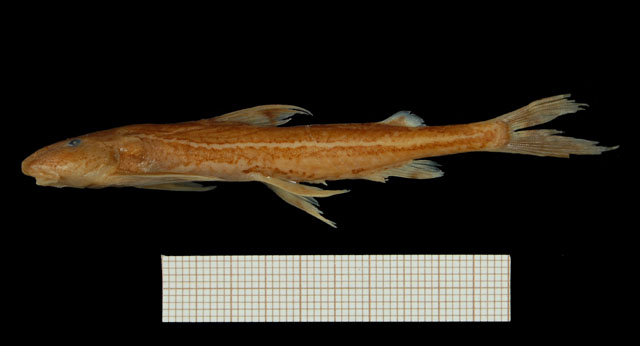|
Dorsal spines (total): -0; Dorsal soft rays (total): 7; Anal spines: -0; Anal soft rays: 8-11. Diagnosis: caudal peduncle long and moderately compressed, narrowest at base of caudal fin (Ref. 57128). Caudal-peduncle length comprised 4.5-5.2 times in standard length, its depth comprised 2.5-4 times in its length (Ref. 57128, 81646). Distance from head to dorsal fin 0.7-1.0 times the head length; posterior nostrils at same distance from eyes than anterior nostrils from snout tip (Ref. 57128).
Description: body slender (Ref. 57128, 81646), depressed anteriorly, tapered to caudal (Ref 81646). Head heart-shaped (viewed from above)(Ref. 57128), flattened ventrally (Ref. 81646). Snout bluntly/obtusely pointed (Ref. 57128, 81646), longer than post-orbit, 0.55 to 0.63 times length of head (Ref. 81646). Eyes small (Ref. 57128, 81646), widely separated (Ref. 57128), orbits separated by distance 2.5 times orbit diameter (Ref. 81646), dorsally positioned (Ref. 57128). Anterior nostrils located on anterior half of snout, posterior nostrils on middle of snout (Ref. 57128). Mouth small (Ref. 57128), ovoid and subterminal, with a median triangular fold on lower lip (Ref. 57128, 81646), upper lip papillose (Ref. 81646). Barbels short and verrucose/papillose (Ref. 57128, 81646), tapered (Ref. 81646), maxillary pair reaching to orbits (Ref. 57128, 2/3 head length (Ref. 81646). Branchiostegal membrane continuous ventrally, its margin broadly curved or straight (Ref. 57128, 81646). Supra-occipital process well separated from dorsal fin (Ref. 57128, 81646) by gap equal to its own length (Ref. 81646). Short obscure humeral spur above gill openings (Ref. 81646). Fins pointed and well-developed (Ref. 81646). Dorsal fin base before origin of pelvics (Ref. 81646). Dorsal fin broad (Ref. 57128), triangulate (Ref. 81646), its first ray longest (Ref. 57128, 81646), trailing edge straight (Ref. 81646). Pelvic-fin insertions located below posterior part of dorsal fin (Ref. 57128). Pectoral and pelvic fins large and falcate (Ref. 57128, 81646), their principal ray broadened (Ref. 57128), pectinate and padded (Ref. 81646), filamentous on outer margin and covered by a thick pad (Ref. 57128). Pectoral not reaching pelvics; pelvics nearly reaching base of anal (Ref. 57128, 81646). Slit-like pore present on either side above pectoral fin (Ref. 57128). Adipose fin short (Ref. 57128, 81646), rounded (Ref. 57128) or obtusely triangular, above and behind posterior half of anal base (Ref. 81646). Caudal fin forked, with the lower lobe longer than upper lobe; 7+8 principal caudal fin rays (Ref. 57128). Ano-genital pores mid-way between pelvic and anal fin bases (Ref. 81646).
Coloration: dark brown above, with (3) paler cross-bars and spots/saddle-patches on back (Ref. 57128, 81646). Lateral line underlined by a white band (Ref. 57128) or wavy stripe (Ref. 81646). Lower sides and belly pale beige, with dark spots above pelvic- and anal-fin bases (Ref. 57128). Fin rays brown (Ref. 57128), with dark brown cross-bars (Ref. 57128, 81646) near tips, fin membranes clear (Ref. 57128). Head with small dark brown spots and dark brown preorbital stripes (Ref. 81646). |

